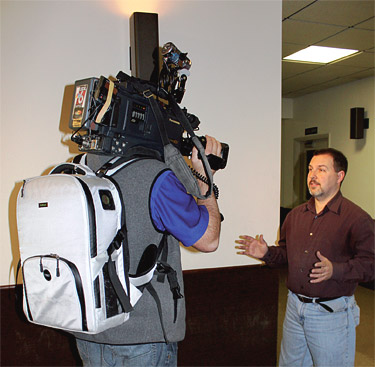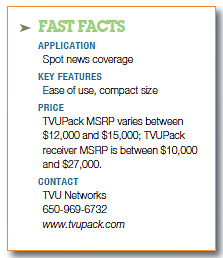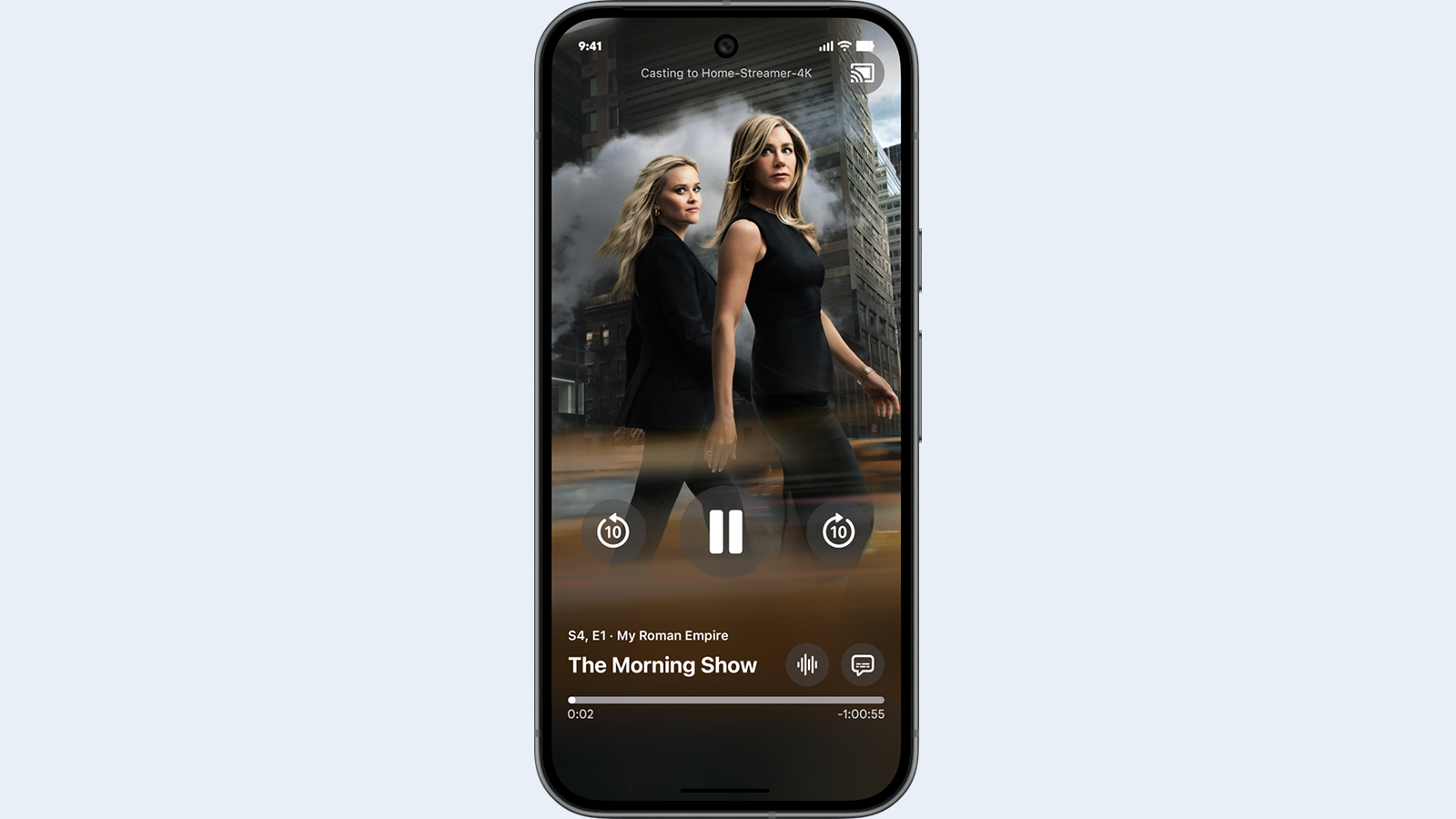
The TVUPack in use
I don't know if it was the first major world news event to be broadcast live on television, but certainly Queen Elizabeth's Coronation in 1953 was indeed paramount at the time. The resources and manpower to bring that story to viewers were enormous by today's standards: with cameras as heavy as refrigerators, cables thicker than some fire hoses, and enormously elaborate connectivity arrangements for relaying video, making the prodiction itself newsworthy.
Until very recently, the modern approach to that type of news coverage usually involved a slightly more modern camera, with or without a tether, feeding either a single satellite uplink or ENG microwave truck. Of course, the level of on-site production (number of cameras, talent, graphics, and the like) varies with the enormity of the story. However, for pure newsgathering, the story hasn't changed much in the last 50 years, involving either microwave—or more recently—satellite relay of signals.
Riding the wave of broadband (cellular-based) connectivity are technologies that have transformed the ENG landscape seemingly overnight. Data speeds of 2.5, 3, 4 Gbps and beyond, combined with the latest advances in A/V encoding and decoding are producing delivery platforms that can rival microwave and satellite ENG quality, while levying a fraction of the cost. One of the companies employing this new technology is TVU Networks, an online content provider and distributor based out of Mountain View, Calif. Their new TVUPack is designed for fast paced, mobile audio/video acquisition-delivery, with minimal reliance upon technical expertise in the field.
FEATURES
The TVUPack system consists of a backpack encoder/broadband delivery package and a server at a central location (studio) to receive and process the audio/video content. This is analogous to a transmitter and receiver, except that the field pack can also record up to 12 hours of content for off-line delivery.
The backpack has three main sections: the first of these (the bottom) contains a rectangular chassis that houses a Linux-based PC for operation, encoding and connectivity; a PC/video screen, and dual Anton/Bauer Gold-Mount battery receptacles. The second section provides access to the top of the chassis, including the DB-25 breakout connector and battery connectors, and the third section allows access to the compartment where the broadband (USB) phone-cards are located. The back flap of the backpack zips down to reveal the monitor screen and the only button on the box. Cooling fans are located on the sides of the pack. The backpack measures about 13-inches wide by 18-inches high, and weighs about 21 pounds when fully populated with batteries. Connectivity provisions include 10 USB ports, one RJ-45, a FireWire connection, and about any type of other audio or video signal connectivity imaginable via the DB-25 breakout cable—including HDMI, SDI, and composite. The backpack unit supports all wireless broadband formats, uses H.264 encoding for low latency (2-4 seconds), and has forward error correction.
The 1RU rackmount server (receive unit) operates under Windows 7, and resembles any ordinary server. However, the DB-25 breakout cable provides plenty of options for audio/video formats. While the unit is a server, the software application is very broadcast-centric, and most functions are performed via a mouse.
There are two primary viewing options using the TVU Transport Mobile Terminal operating software: Basic and Advanced. These views are selected by a tab at the top right of the screen. In the Basic view mode, video is displayed in a window that is about 1/10th of the screen size, in the upper-mid screen, along with a stereo audio level meter, and a start/stop tab. There are 10 "LED-looking" indicator lamps that show the status of each broadband card. If the indicator is dark, then the card is disconnected. Red means the card is dialing, yellow indicates it's connecting (negotiating), and green signifies a "connected" card. Above each indicator is an IP address.
Status and Mode windows are provided on the right side of the screen, with the Mode window displaying either Interview, Normal, Fast Moving, HD, and Refresh. The Status window displays quality, error rate, and line quality. Switching to the Advanced view replaces the Mode window with a File window, which shows a timeline, a display of files ready to be transferred, and buttons for refreshing, downloading, playing, and deleting. In addition, the "LED-looking" card status indicators are replaced by five minute "histogram" displays indicating signal quality in a graphical manner.
IN USE
Upon receiving the two units, the first task was to install the server at our studio operation. After mounting it, I connected the monitor, keyboard and mouse, along with house audio and video signals to the DB-25 breakout cable.
I then powered up the TVU Backpack by installing a fresh Anton/Bauer brick battery, and connected outputs from a Panasonic HVX-200 camera to the connections on the DB-25 connector labeled "Analog Audio" and "Composite Video," and pressed the single button on the TVUPack unit. The boot-up process began, with the power switch giving off a nice green glow. After about several seconds, the screen displayed a DOS-like presentation with the TVU company name, unit ID information, status lines for each of the 10 broadband cards, and a prompt that said: "To broadcast live, please power on the camera and connect it to TVUPack. Cards 1 through 6 indicated in red letters that they were "dialing," while those in positions 7 through 10 displayed "No USB-PPP Card." According to the technical staff, the unit was shipped with two Verizon cards, two AT&T cards, and two Nextel cards. After a few more seconds, all six card status indicators displayed "Connected" in green text. Back at the server, the Basic display agreed that six cards were indeed connected. However, and to my disappointment, there was no video or audio.
After about 10 minutes spent in double-checking everything, I called the TVUPack tech support department.
Shortly, I was on the phone with a tech person. We talked for a few seconds, and as I suspected, the demo unit had last been at a facility that used SDI for video input. The support person asked if I wanted to fix the problem under her direction or if I wanted her to take care of it, as she had already connected to the boxes. I decided to try this new approach to troubleshooting and took that opportunity to get coffee while she typed in a few commands via the Internet. By the time I'd returned with my coffee, there was a nice video image on the TVUPack backpack display (it had replaced the phone status), and on the server monitor screen. I double-checked my house router, and had audio and video there as well.
After familiarizing myself with the system, I sent a test shooter out with the TVUPack/camera system. (For the record, we're located in Paducah Ky., which has a population of about 25,000, and another 40,000 persons living in the county. While we are not located in a metropolitan area, there is 3G service available throughout most of the city, and the county has a moderate level of 3G service.)
As the shooter left with the TVUPack fired up, I switched the view to "Advanced." (This was one of the neatest parts of this whole test—I could evaluate cell service in our area using the histograms.) As the graphs are not labeled for a strength value, I'll make my comments regarding signal quality in percentages of full scale. Basically, two of the cards showed practically no signal quality (0 to 10 percent), while another pair showed slightly better service (20 to 30 percent). The third pair; however, displayed about 50 to 70 percent on the quality scale. As the shooter drove down the Interstate toward our shopping mall area, video/audio quality was really good, but there were occasional dropouts as his vehicle moved along the road. When the vehicle stopped at traffic lights, the signal was somewhat more robust, but there was still some breakup. We lowered the quality of encoding, but the breakups continued. (It should be noted that after discussions with the TVUPack people, for our testing the mode was set to "Normal." My interest in this unit is primarily a "first on scene" newsgathering tool, therefore we did not test the "encode then file transfer (FTP)" feature.
When our shooter arrived in downtown Paducah, the quality improved and we had solid audio and video. The quality was such that it would have been possible to do a live remote in that region.
Then the driver traveled around the area for about 45 minutes, with mixed results with audio and video. When breakups did occur, video was the first to suffer, with the audio often not affected at all.
In short, it would appear that our 3G service is not as solid as is advertised by various service providers.
During this test, we operated the unit for more than an hour, and the battery still indicated a partial charge. It's likely that the advertised 1.2 hours of operation from one battery claim is accurate.
To give the TVUPack a proper test (and to confirm my suspicions about our local 3G service), I got permission from the TVUPack folks to send the backpack to Nashville, Tenn. for a little 4G workout.
A few days later, one of my buddies had the unit fired up while driving 70 mph on I-65 around Nashville. Audio and video were as solid as rocks. There was only one small glitch during the 20 minutes or so that I observed the test, and I think that was when one cell site probably handed off to another, catching the FEC at just the wrong time. During the Nashville test, the quality meters on the Advanced display didn't read any higher signal quality than what we experienced back in Paducah. In fact, the numbers were slightly lower. Performance around downtown Nashville was solid—the audio/video quality was first rate, and the latency ran between two and four seconds.
SUMMARY
I love the Linux OS, and have a lot of confidence in it. The display is simple, the system could not be easier to operate, and the tech support provided by the TVUPack people was first rate. I didn't expect microwave quality from the unit, but the tests from Nashville rivaled traditional "broadcast quality." Certainly for a "first-on-the-scene" tool, it's outstanding.
Regarding tests around my hometown, I suspect that the network here is weak and barely working, and this has probably been the case for some time, (This isn't the first remote encoding system we've tried.) If you're wondering if your 3 or 4G system could support the TVUPack, I can almost guarantee that they'll send you one to try. However, these systems are not inexpensive.
Joey Gill is chief engineer at WPSD-TV in Paducah, Ky. and has been with the station for 30 years. He has worked in television since 1977. He may be contacted at respond2jgill@yahoo.com.

The professional video industry's #1 source for news, trends and product and tech information. Sign up below.
